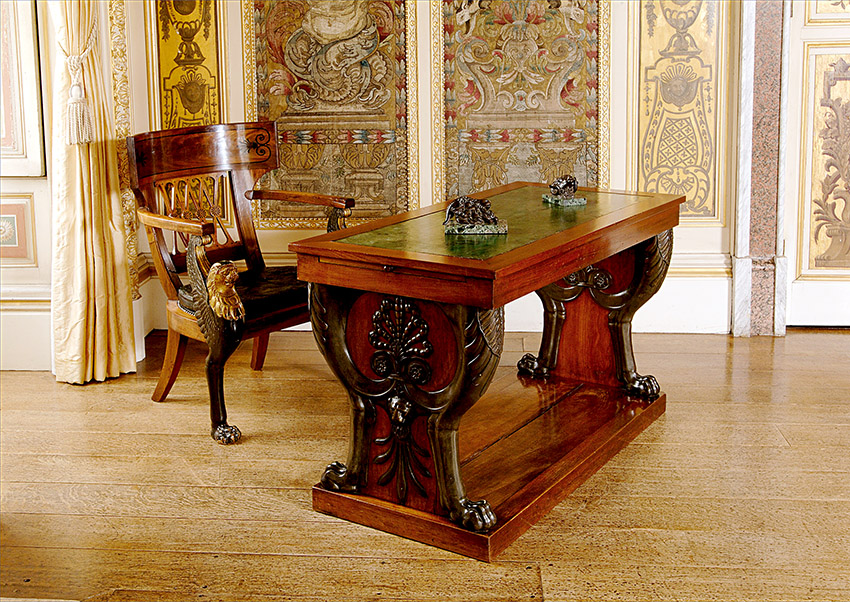
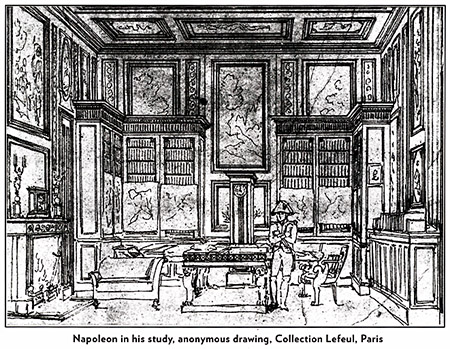 One of our most important works of art is a desk and chair in the Music Room. They both belonged to Napoleon Bonaparte and are by the Jacob family of furniture makers. Under the arm of the chair is the date 1802 and the letter “C” meaning that it was made when Napoleon was Consul before crowning himself Emperor in 1804. There is an impressive brass plaque at the back.
One of our most important works of art is a desk and chair in the Music Room. They both belonged to Napoleon Bonaparte and are by the Jacob family of furniture makers. Under the arm of the chair is the date 1802 and the letter “C” meaning that it was made when Napoleon was Consul before crowning himself Emperor in 1804. There is an impressive brass plaque at the back.
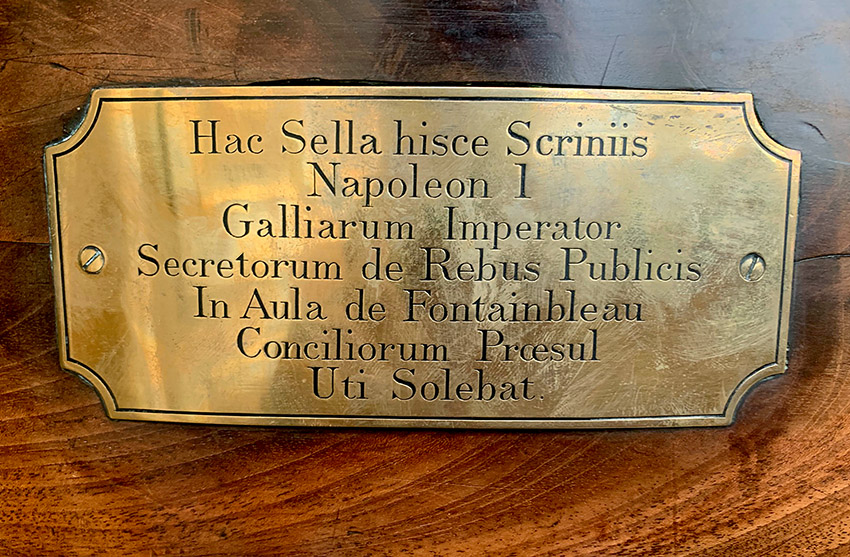
This Latin inscription reads “This chair was used by French Emperor Napoleon I while conducting public affairs in the Hall of Fontainbleu Council”
The Frères Jacob inherited the family business from their father, Georges Jacob, a highly regarded artisan during the time of Louis XVI and on the underneath of the desk is the signature “G Iacobis”. Following this, and various other commissions from Bonaparte, his sons too achieved similar success.
I think the British have a quixotic and reserved appreciation of Napoleon. He dominated Europe for more than a decade and left an enduring political and cultural legacy: celebrated and feared for his military acumen but a controversial figure given the cost to human life of his political ambitions. The final defeat was of course at Waterloo.
Nevertheless Andrew Roberts, a friend of mine and, more importantly, a highly regarded historian and biographer of Napoleon, comments, “The ideas that underpin our modern world—meritocracy, equality before the law, property rights, religious toleration, modern secular education, sound finances…were championed, consolidated, codified and geographically extended by Napoleon”. Napoleon himself said “My true glory is not to have won forty battles … Waterloo will erase the memory of so many victories. … But … what will live forever is my Civil Code”.
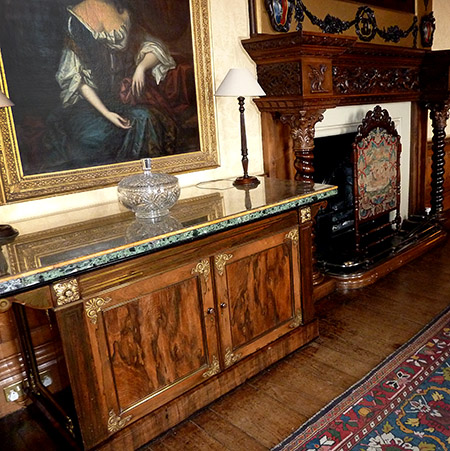
A sideboard in the Dining Room, also by Frères Jacob.
The only thing about our desk which is not entirely clear is at what point it was purchased by the Carnarvons. After Waterloo the British exiled Napoleon to Longwood House on the island of Saint Helena, 4,500 miles from Paris, where he lived, taught himself English and struggled with the maritime climate. After Waterloo, George Bullock, a respected and celebrated London cabinetmaker, was commissioned to make a suite of furniture for him. Coincidentally his workshop was behind the Carnarvon’s London house and the Carnarvon’s also owned a desk and other furniture made by George Bullock, some of which was subsequently sold by the 6th Earl, Geordie’s grandfather.
The question is whether the 2nd Earl of Carnarvon, who was in Paris during 1814/15, bought the desk, like others, as a memento and souvenir or whether Napoleon was permitted to take the Freres Jacob desk with him to St. Helena and it formed part of the sale of Napoleon’s goods after his death in 1821.
The only record we have is a note, which could have been attached to either desk and which reads:
“Coloured transparency of the label glued to the desk: signed by Chaplain at St Helena, 11 Apr 1827, certifying that “This Table was purchased at the Sale of Napoleon Buonaparte’s effects at St Helena after his decease, as part of the furniture of Longwood House / R Boys / Senior Chaplain” [The Revd Richard Boys (1785-1867), Junior Chaplain to the Honourable East India Company on St. Helena, 1811-15, and Senior Chaplain, 1815-30]”.
Perhaps as infamous as his military exploits, was Napoleon’s tempestuous relationship with his wife. He married Joséphine de Beauharnais just before his coronation and her name was on his lips as he died. Such was her renown that her name, Empress Josephine, is still almost universally recognised in itself.
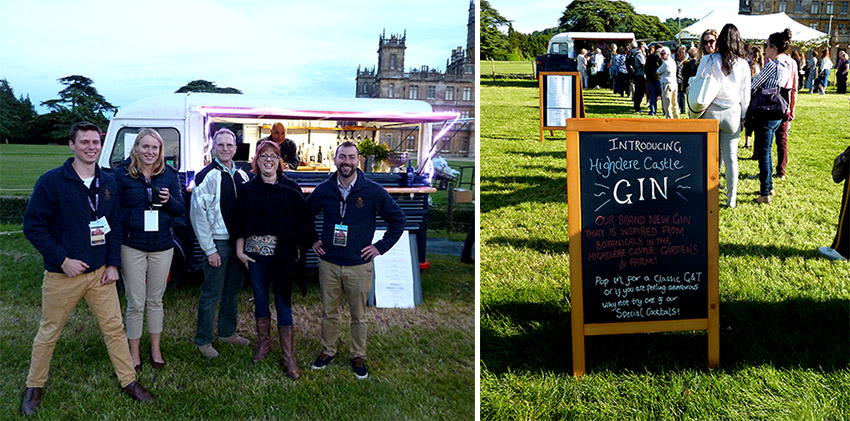
These days, at Highclere, we have a little vintage French Citroen van, smartly painted blue and red, from which Luis (Highclere’s Carson) and his team produce cocktails or coffee, depending on the event and the weather. In honour of our desk, and the van’s nationality, we have called her Josephine and, living up to her name, she was a star attraction this past weekend during the Downton Abbey Live Evening. We could not make the Gin cocktails fast enough and at points the queue was overwhelming, though everyone was marvellously good humoured.
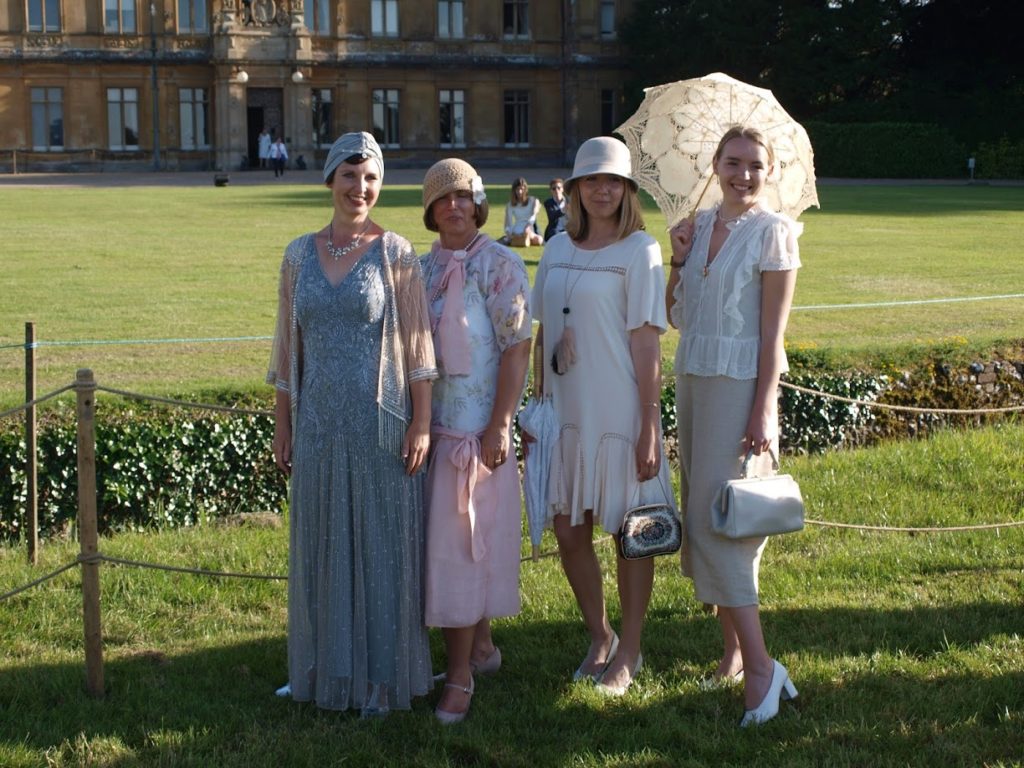
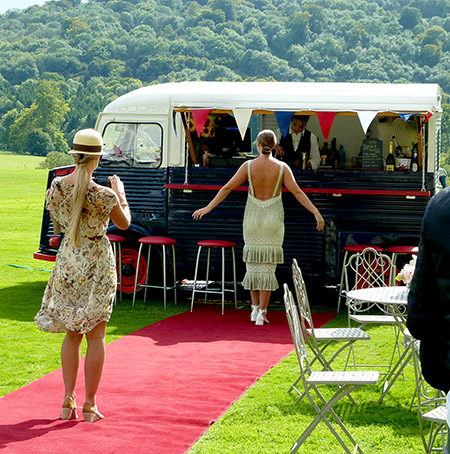
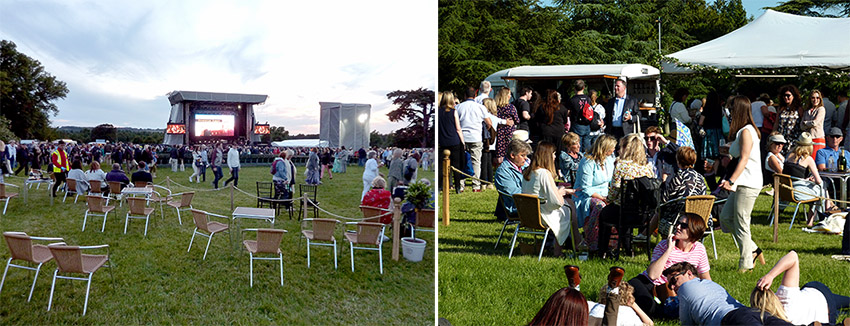
It was a magical, lovely summer evening. Jim Carter (the real Carson) was faultless – his voice so distinctive – and we re-lived favourite scenes and music from all six TV series played by some superb musicians and talented singers. I hope the rest of the audience enjoyed it as much as I did and that we might be able to curate another similar event again the same time next year.








 Instagram
Instagram
Such a delightful evening, stunning location and music….and perfect weather. So lovely to meet you again and to chat with you and your publicist about your new book out in September. Meanwhile excited to try out some gorgeous recipes from At Home at Highclere.
Thank you!
Lovely posting today with the video bringing back the memories of the brilliant stories of “Downton Abbey” & all the characters- so enjoyable this Monday morning. Congratulations on the success and would love to attend the next event. Brilliant music has taken its place in public memory. Thank you for sharing. Ida
Well, hang on to the desk. A brief glance at this article will indicate the wisdom of your doing such……..
go to:
https://www.nytimes.com/2014/11/17/world/europe/in-new-napoleonic-era-his-hats-and-stockings-rise-to-power.html
Advisedly as ever,
David Terry
How interesting!
We missed the live concert. My two daughters, my sister and I booked our tickets, flights, accommodation and car hire at Christmas. We left Glasgow heading for Southampton and just before Blackpool the pilot announced there were no electrics on board and there was engine trouble and we had to go back to Glasgow. To say we were disappointed is an understatement! No other flights available to us and there was no way we could drive after a few hours sleep and a terrible ordeal on board. We had been looking forward to this concert for so long. Hope there will be another one and we will book the train next time!
Oh no – what a terrible experience for you! I am relieved to hear that you are safe. We will no doubt be having more Downton related events throughout the coming year so do look out for those.
Thank you for the pleasant memories.
You are very welcome
Dear Lady Carnarvon,
Your writings translate so many marvelous stories into reality for us all. Beautiful history and glorious events… thank you! The photographs and the video are absolutely wonderful.
I look forward to next Monday!
Best regards,
Charlotte Merriam Cole
Thank you
good morning from midwest city oklahoma
the video was a respite from the heat of the season – altho we’ re having a truly wet time this year – my grass is quite green.
i owm all seasons if DA but hearing the music on the video was delightful.
ineed to buy your At Home book and the receipes – I have the original books on Downton.
looking forward to the movie
Dear Lady Carnarvon,
I’ve been following your blog ever since a visit I made there in April. I am enjoying it very much, and especially this one about Josephine. I have visited Malmaison outside of Paris and find it charming.
Could I ask you about a 2020 event you mentioned recently – May 10th to 16th, about Cooking and the history of cooking. I see it is now called the Highclere Spring Festival, but the same timing. I am going to be in your area on May 10, 2020, and had been hoping to be able to visit Highclere again. But when I spoke to the booking people in April they said it was not on the calendar, that Highclere would not be open. Can you clarify that for me?
Barbara Wendell
We have only just finalised the dates of the Highclere Festival – 9th to 16th May 2020. As this is a special ticketed event, during that time the Castle is closed to the general public so I think this is perhaps where the confusion occurred. Full details and ticket information should be on our website in the next couple of months.
It was an absolutely perfect evening for us! We were so happy to be a part of it. Thank you for the wonderful hospitality. We hope to attend again in the future!
Warm regards from Texas,
Jennie Syamken
I am so glad you enjoyed it – what a spectacular evening it was.
Dear Lady Carnarvon,
I am a big fan of desks and it was a really great blog this Monday. I have a JAS Schoolbred roll top 1890’s desk once owned by a Disney Imagineer. Not quite Napoleon but the previous owner created the Thunder Mountain ride for Disney attractions. What a wonderful turnout for the Downton Abbey Live event with James Carter. I marvel at each Monday blog that I read. Thank you so much for sharing.
Ciao,
Harold Granzella
A good desk is essential for good thinking.
Thankyou so much again for a wonderful evening! The castle looked so beautiful in the sunshine and the concert was excellent. Please thank Louis for the marvellous cocktails!! We really appreciate everyones’ hard work, thankyou xx
Thank you – it was a real team effort.
Lovely! I so enjoy and look forward to your posts!
Another absolutely fascinating and MARVELOUS post Lady Carnarvon. Wish I could have attended the Downton Abbey LIVE evening. We’ll have to settle for seeing the movie – DOWNTON ABBEY when it airs this September in the states. I’m still grateful I was able to visit your home back in May.
Looks like it was a perfect evening for such an event. Looking forward to a visit in the near future.
Will you host an event for the movie premiere?
Lesley Revuelto
Dallas, Texas
We will no doubt have some more Downton themed events over the coming year.
Another wonderful Monday morning history lesson. A visit to Highclere is on our bucket list. My husband is recovering from a TAVR but said he feels ready to travel again. It would be a thrill to see the castle and the piece de resistance would be to meet you, Lady Carnarvon. In the meantime, I must be contented with reading your delightful stories and living vicariously through them. Thank you for that.
Sincerely,
Theresa Franz
Please do come as soon as you are able.
“The question is whether the 2nd Earl of Carnarvon, who was in Paris during 1814/15, bought the desk, like others, as a memento and souvenir or whether Napoleon was permitted to take the Freres Jacob desk with him to St. Helena and it formed part of the sale of Napoleon’s goods after his death in 1821.”
This sounds like a job for BBC’s ”Fake or Fortune’s Philip Mould & Fiona Bruce! In particular the part you mention: “The only record we have is a note, which could have been attached to either desk..” You never know, while they specialize in artwork, they might have access to some of the best sleuths in the art world who also specialize in furniture.
Such an incredible piece of history to own.
Jody
That’s a very good idea!
Thank you so much for sharing the video of Downton Abbey Live!
Even though I own the whole series it is playing again on PBS in the States and am watching it all over again each week.
I’ve so enjoyed my visits to Highclere and hope in the future I can attend a future Downton Event.
Do you have anything planned for when the Movie comes out?
I so love your blogs each week and photos of Highclere! I’m sure there is considerable work involved to keep them coming and I thank you for each and every one of them!
We will have some other Downton related events over the coming year so keep a watch on the What’s On section of our website.
Oh, to have been there! It must have been a beautiful event, perfect weather, and what a lovely sunset with Highclere Castle and Downton abbey music! Thank you for sharing with the video and the great photos. ‘Would that I could have been there, ’tis on my “bucket list” to return to Highclere, one day, someday…maybe in September. It is always a joy to read your blog on Mondays, ‘almost like being there. You have a most perfect way of writing and bringing us all into your home and your life at Highclere. Many thanks!
Thank you – it was a wonderful evening.
We visited Highclere on June 5 and were so delighted to finally be able to visit. The chair and desk were exciting to view as we had just visited his home in France the week before.. Our guide was very informed, the tea afterwards was so nice and to get a copy of you book autographed, was the icing on the cake. I even spied your two beautiful dogs going out from the farm buildings!!! Thanks for the great blog and the excitement of finally getting the train to Newbury and visiting your wonderful home.
Thanks for the incredible memories!
Ginger Winger
Fort Lauderdale, FL
I am delighted you enjoyed your visit. Our two youngest dogs – Stella and Freya – are often to be seen around and about, making friends and looking for treats.
Thanks for the wonderful recap of the Downton Abbey event. Though I am not much of a traveler any more, it is most enjoyable to share in the spirit of the event via your posting and the video. I understand the amount of work that goes into such an event and I hope you raised big money for your charities. THANK YOU!
(Stan W, Portland, OR USA)
It was a wonderful evening and we were so lucky with the weather.
WOW! That is amazing that you have that historic furniture – The Carnarvon’s have a place in history all their own. So delighted that your event went off so well attended. I felt so bad for the family that couldn’t make it due to their travel woes. Traveling can be fraught with problems and you have to “go with the flow”, but still to miss that concert had to be heartbreaking. I’m praying for a safe delivery to our Highclere tour in August – we will be taking the train as Rona suggested! Thanks for another lovely start to the week…
Thank you
I just got goose pimples watching that minute and a half clip. As of late, every time I see Jim Carter on Knightfall I growl at his character. However, seeing him in that lovely tuxedo took me right back to falling in love with him (and his voice) on Downton Abbey. Only an amazing actor can do that. That must have been a magical night. Thank you for sharing this with the rest of us that couldn’t be there.
Jim was absolutely wonderful – his voice, his demeanour, he really brought the whole production alive.
Thank you so much for hosting us! My sister, my husband and I came over from Australia for the concert and the reception. To say we had a fabulous time would be an understatement. This visit was very much worth the trip across the world. We feel very privileged and greatful to have visited your lovely home and to watch such a well put together, flawless concert. Our two bottles of Highclere gin will sit pride of place in our Sydney home. Thank you so much!
Golly – you did come a long way. So glad you enjoyed the concert – it was wonderful. And the Highclere gin should sustain you!
I enjoy so much, reading your notes from Highclere! I hope to visit one of these days.
Please do come and visit.
Thank you so much! I was there last year on the 23rd and saw that desk and chair. I was very curious about how it came to belong at Highclere! It appears the mystery will never fully be solved.
Dear Lady Carnarvon,
Thank you for another historic story. The desk and chair that belonged to Napoleon is very detailed and has a beautiful chestnut wood color. The story behind Napoleon and Josephine has always been fascinating to me. I have read several books on Josephine’s life. And, I have to say, her ending was not fair for a woman who struggled so much in life. Nonetheless; Napoleon has his merits too. Congrats on the Downton Abbey musical event. I always listen to the music at home and in my car!
Dear Lady Carnarvon,
I would like to raise a glass of Gin with you and celebrate your beautiful home and you,however,I
do have some cheap brandy in m cupboard with the name Napoleon does that count? I’m wishing you the best on this glorious Summer day and I wish everyone at Highclere a lovely day too. I would recommend you all stick to ice cream not Gin especially if you are greeting the tourists!! Wouldn’t want to give the wrong impression to one’s guests do we??(wink,wink)
Fond Greetings,
Ann Catherine Flood
Hello from Florida!
Another very interesting and informative entry! You never disappoint. I am excited to hear that there may be future events that we can plan to attend. We really wanted to be there. It sounds as if it was a magical evening with wonderful music and company…
The next time we are able to visit, I would love to have more time to explore Newbury. It was a delightful town with friendly people. Our time last September was limited, so exploring was not an option. I must say how much we enjoy the train system in the UK. What a relief to ride along without the stress of fighting traffic in a car!
In America the toys I played with as a child in the 1950’s are considered antiques!! England is a different story. I can barely wrap my brain around a chair once owned by Napoleon, and the relics from even earlier are amazing. We visited a Cathedral built by my ancestors in the 1200’s!
I really enjoy reading about the rich history of Highclere and the caring people who live there. I am especially fond of Luis and Matthew. They were both so kind to me when we visited the first time. I will always be grateful. Their contribution to that day was a huge part of what was a wonderful experience.
I hope I haven’t rambled on too much. Forgive me for that.
Thank you…
L. Sue Smith
Englewood, Florida
Thank you for your thoughts -I go by train whenever I can !
Dear Lady Carnarvon,
The event looked like a complete success. In all the photos everyone seemed to be having a wonderful time. My husband and I look forward to visiting Highclere Castle in May 2021 in celebration of our 40th wedding anniversary. In the meantime, reading your blog every Monday brings a bit of Highclere to us and we love it. Thank for sharing with us each week.
Sincerely,
Mary Watkins
West Memphis, Arkansas
Thank you!
Perfect evening for a beautiful event. It was a treat to have Julian Fellowes on stage to close the performance and to see John Lunn recognized for his accomplishments. Lord Carnarvon was kind enough to say hello during the intermission.
It would be quite special to have a Downton Abbey movie screening at Highclere Castle in the fall beneath the stars. Fingers crossed.
Lucia
Wow! You and your entire staff have done it again! Loved seeing the desk and chair last year AND loved being with you at Amy’s New Orleans conference. Between your and Elizabeth Gilbert’s outstanding presentations, I came home committed to finishing my book. I’ve done that (still plenty of editing and re-writing left) and am now working on the book proposal in the hopes of finding an agent and publisher. Thank you for your inspiration!
thank you – I enjoyed New Orleans!
Oh how I wish I could have been there at this time! I pray I will one day be able to visit your lovely home.
I remember being fascinated by the Desk on a visit 2 years ago as was my Panamanian wife who absolutely adores Highclere!
We were blessed to be able to attend the concert on Saturday the we enjoyed immensely and all the organisation and staff were superb!
I even had the honour and pleasure of shaking your hand!
Thank you again for the brilliant blogs.
Thank you so much!
Dear Lady Carnarvon
I am so glad that the Downton Abbey Live Evening was such an enjoyable and successful event. Thank you for posting the clip.
With respect to the chaise et bureau de Napoléon, do there exist any secret compartments/drawers?
My wife had a writing bureau which has been passed down through multiple generations in her family. The intricate woodwork and craftsmanship are magnificent.
But the real joy of the bureau lies in its secret compartments and the manner in which they are accessed. We keep wondering if we have found them all!
On the topic of Napoleon many legacies, I have heard it said – particularly when I have been in London – that it is because of Napoleon that the traffic in continental Europe travels on the right side of the road. The story goes that in days of yore, as most people were right handed, they rode their horses on the left side of the road so that they could either greet fellow travellers passing by in the opposite direction with their right arm/hand and/or clearly show that they were unarmed.
However, Napoleon was left handed and it was more appropriate for southpaws, such as himself, to ride on the right side of the road. Napoleon therefore included in his codification of the law, a requirement that all travel was to be on the right side.
Hence, every country that Napoleon occupied was forced to do likewise and that is why those countries and their colonies now drive on the right side of the road. Of course, that “theory” does not explain why vehicles are driven on the right hand side of the road in the United States. Maybe it is just a story?
I also have heard it said that, before the French revolution, the French aristocracy used to travel on the left side of the road and in doing so forced the poor onto the right side of the road, out of the way of the wealthy. (I’m not too sure what happened when two convoys of the aristocracy approached each other in opposite directions, but why let that curiosity get in the way of a perfectly good story?)
Anyway, what does appear clear is that, for whatever reason, after the revolution Napoleon did direct the army to travel on the right side of the road The law was included in Code Napoléon. The rest, as they say, is history but the real reason for codifying that law might be destined to remain a mystery?
Maybe the answer to this conundrum lies in a hidden compartment within a very special desk in the Music Room at Highclere Castle?
Yours faithfully,
Jeffery Sewell
Other desks have secret compartments – this is more plain.
Napoleon rose on merit to the top and cut through much of the flummery on the one hand and on the other brought the revolution in France to an end.
What a wonderfully descriptive word is “flummery”. Love it!
By the way, I believe this coming 15 August marks the 250th anniversary of Napoleon Bonaparte’s birth. Somewhere surprisingly, I have heard very little of any events celebrating the occasion, other than there being a fireworks display th at evening in Corsica and a couple of days of days later, there will be some form of re-enactment of Waterloo by the youth in Belgium.
Over night. I also recalled another most important contribution to world history that comes from the Napoleonic era. In particular, during the Napoléonic campaign in Egypt in 1799, a French soldier named Pierre Bouchard discovered the Rosetta Stone, which of course provided the means of cracking the code to Egyptian hieroglyphics, that basically had been a “dead” language for almost 2,000 years.
Before concluding, I also should make mention of one of my favourite paintings – the magnificent 10m x 6m painting by Jacques-Louis David of the Coronation Of Napoleon at Notre Dame Cathedral. The moment captured in time by the artist – viz. of Napoleon placing the Crown Of the Empress on Josephine – is powerful and imposing.
Yet, as glorious as that painting is, I feel that, in the world of art, Napoleon was outshone by his younger sister, Paolina (“Pauline”), who was the subject of/model for Antonio Canova’s sculpture of Venus Victrix. That magnificent marble sculpture adorns the Borghese Gardens’ Museum, which is a must visit destination when in Rome, but book well in advance.
It is my understanding that Antonio Canova was heavily influenced by the discoveries of Pompeii and Herculaneum.
Ciao.
Thank you Jeffrey – and to add to Canova’s legacy – his school led to the statues at Highclere
How appropriate.
I have heard art critics say that, whilst Canova was inspired by the Baroque and the classical revival, he avoided the “flummery” melodramatics of the former, and the cold artificiality of the latter.
Maybe that is part of why Highclere is so welcoming and warm; not to mention the wonderful family who occupy her rooms and so carefully tend to her estate.
Finally, on a completely different note, I am very much enjoying watching or listening to the Cricket World Cup, even if it keeps me awake to the wee small hours in Sydney. I certainly enjoyed last night’s match and hope that a rematch in the semifinals between Australia and England can achieve the same result.
Dear Lady Carnarvon,
Thank you for the snippet of history, and the photos of your home and grounds.
If you don’t mind, I have a couple brief questions-
The sideboard pictured in the Dining Room has beautiful wood grain door panels. Might I inquire if you know the kind of wood used?
Also, the floor in the Music Room and the Dining Room are simply wonderful. Do you happen to know what wood was used in them? The Music Room looks distinctly lighter.
It really sets off the darker desk nicely.
We’re so happy Downton Abbey has returned to Public Television to be shown in its entirety.
Sincerest Regards, Jane Hrabak
The sideboard is made from rosewood with a top from the Mona Marble quarry on the Welsh island of Anglesey.
The floors are oak – the light gives a different tone – I imagine oak from Highclere
Silly question, I know, but where did everybody park?
Such a good turnout!
In a field just behind…
I live in the USA now and have done for 39 years, when reading your posts it brings my love of history and English countryside to the forefront of my mind.
Thank you
Thank you for reading!
Thank You So Much! What a wonderful evening! The Concert was captivating, it was a life time experience.
In addition we had the opportunity to see not only your amazing residence but the Egyptian Exhibition was outstanding.
Our Thanks Again.
Wonderful – I am very glad, thank you
Lady Carnarvon,
I missed my early morning read due to an exhausting appointment at the eye doctor, so have had to put off the delightful Highclere history link with one of Europe’s great warriors. It is amazing the talent and artistry that went into the thronelike chair and very masculine desk. And a “thank you” for bringing readers back into the early 20th century as Downton Abbey returns soon.
Martha Glass
Dear Lady Carnarvon,
Oh, thank you so much for posting this video of the concert! (Especially the drone shot…I kept trying to determine where the stage was set up, so that was great!)
I learn so much from your blog posts. When I visisted Highclere this past May, I wish I had paid closer attention to that marvelous desk…it’s incredible. Oh, well – I guess I’ll have to return.
I look forward to your Highclere stories every week – thank you.
Joan Lerch
Saint Louis, MO
USA
Hope you will come back – there is so much detail here!
I can only imagine what an amazing experience the concert must have been and had it not been for a family wedding in Wales the same day, I would have love to attend. However, what a special day today was as my Mum and I took the morning tour of the castle and it was simply fabulous. Everything was perfect and I can’t wait to get home and read through the wonderful book that was included as part of our tour. The refreshments provided at the end of the tour exceeded our expectations. My compliments to the chefs. Thank you for a truly wonderful experience. I’ll look forward to your next blog post.
Thank you so much!
MY DEAR LADY CARNARVON,
CONGRATULATIONS, MYLADY AND STAFF, FOR THE GREAT EVENT.
WHEN WILL THE LIVE CONCERT DOWNTON ABBEY DVD BE AVAILABLE FOR PURCHASE?
LOVELY SUMMER FOR US.
VILA ALEMÃ
RIO CLARO SP
BRAZIL
Dear Lady Carnarvon,
I wanted to thank you again for a very, magical and memorable trip with my daughter. Thanks to you we were able to attend the reception. The castle was every bit as lovely and majestic as I knew it would be. We will forever hold this trip in our hearts. And meeting you was a highlight of my trip, so sorry I didn’t get a picture, but I will always remember the moment.
Thank you again.
Take care.
Sincerely,
Sarah Cameron
Virginia, USA
Thank you Sarah – delighted you came here and it was very nice to meet you and your daughter
Hello!
Yesterday evening looked just wonderful!!! When I am there next year, I know everything will be just great!! Thank you or another interesting blog.
Have a wonderful week.
Lisa Cosgrove, Illinois
My Dear Lady (can I called you in this way or it’s so much ??)
Thanks a lot, thanks and more, to let me, “From the distance” (Bs.As Argentina) enjoy “Downton Abbey Live” in your beatiful Castle!
About the desk, it’s awesome ! you have it there!!! My Godness!!
i love your posts!
Adriana
It is awesome
Wellington called Napoleon the best general of any age.
Lady Carnarvon:
How fun!!! My kind of event as I love music and love dressing up even more!! I would be just like the ladies in the photo you shared– all decked out in their 1920’s attire. The setting looked so beautiful and with the sunset and dusk makes for a most unforgettable experience. Highclere’s gin is a huge hit, it seems–I don’t drink but I sure would purchase a bottle because the bottle itself looks like a collectible!!!
Kind regards,
Bev.
Luis is actually selling the empty bottles following our great success with the cocktails
I’m so inspired by you and your blog. Am I missing a link (maybe there isn’t one…yet) to buy items from the Highclere Gift shop (including, I hope, your new fragrances). From my friends lucky enough to attend, I hear the Highclere music evening was fantastically unforgettable.
There is a gift shop link for our ticket page on our main website – Sally ([email protected])runs the gift shop and can always help with info – I do not have a license to post scent to the USA yet. “1793” is living with me well – beginning to be in my life which I think is how scents have to begin to be. There are so many scents in the gardens at the moment and sometimes I stop, there is something in the air and just think about it, to see where to go next
Oh my goodness… our photo made it on your blog. I feel very honored. (I‘m the lady with the silver gown)
Words cannot express how wonderful it was. The weather was perfect, the music was perfect and the location more than perfect.
I hope you will host an event like this again. I‘m already working on my next outfit.
Thank you so much for this once in a lifetime experience.
Thank you for joining us and your wonderful dresses!
Thank you!!! Lady Carnarvon for sharing with all of us! …. the commoners
Lady Carnarvon,
Thank you for sharing the rich history of Napoleon Bonaparte.
I studied Professional Interior design and can appreciate the quality of that desk!
I love Downton Abbey. Cannot wait until the movie comes out. Love Carson’s character.
And thank you for the pictures. It appears that everyone is having a wonderful time.
Peace,
Phyllis
Thank you!
Thank you so much for such a wonderful evening. It was our second visit to Highclere and unlikely to be the last. The concert was amazing as was the weather! The spectacular sunset behind the stage was just incredible!
Thank You for sharing! I wish I could have been there! Looking forward to visiting next time I’m in the UK!♥️
Now that’s what l call a desk ,how could you improve on that ! It is really a work of art ……
Can’t wait to visit Highclere again in the near future. Thank you again for your stories and information
Thank you Lady Carnarvon for sharing your memories of this special day. We were in the plane that day flying to England and I was so disappointed that I couldn’t be there to see it all. Now I can. We look forward to our day at your beautiful home on the seventh. Hope you enjoyed the DVD.
Kindest Regards
Heather and Malcolm from Australia.